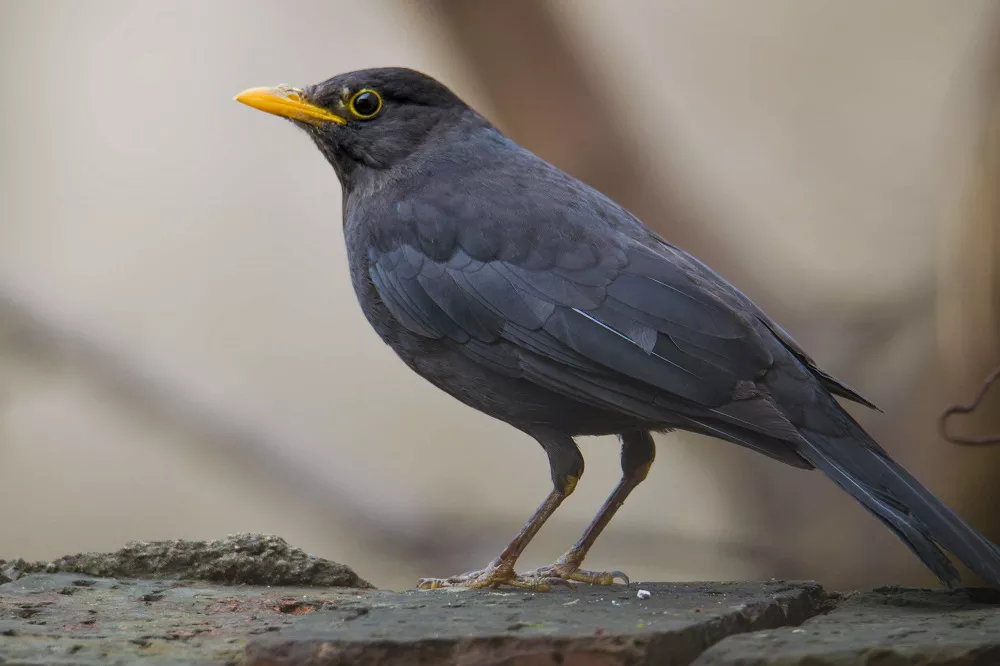The Common Blackbird, scientifically known as Turdus merula, is a widely recognized and intriguing bird species that is native to Europe, Asia, and North Africa. This medium-sized songbird, known for its distinctive all-black plumage and melodious song, holds a special place in folklore, literature, and scientific study. In this article, we will delve into the characteristics, habitat, behavior, and significance of the Common Blackbird, shedding light on the fascinating aspects of this avian species.
Physical Characteristics:
The Common Blackbird exhibits notable physical traits that make it easily distinguishable:
Plumage: Adult male blackbirds feature black feathers with a bright yellow eye ring and an eye-catching yellow beak. Females and juveniles, on the other hand, display dark brown feathers with a speckled appearance.
Size: These birds measure approximately 23-29 centimeters (9-11 inches) in length, with a wingspan of around 34-38 centimeters (13-15 inches).
Weight: The average weight of an adult Common Blackbird ranges from 80 to 125 grams (2.8 to 4.4 ounces).
Habitat and Distribution:
Common Blackbirds have a diverse habitat range and can adapt to various environments, including:
Woodlands: They are commonly found in deciduous and mixed woodlands, where they can forage for food and build nests.
Gardens and Parks: These birds are frequently spotted in urban and suburban areas, often nesting in trees and shrubs within gardens and parks.
Farmlands: Common Blackbirds can also inhabit agricultural areas, utilizing hedgerows and fields as foraging grounds.
Their distribution extends across Europe, stretching from the Mediterranean to Scandinavia, and reaches parts of Asia and North Africa.
Behavior and Vocalizations:
Singing: One of the most captivating features of the Common Blackbird is the male’s melodious song. Their rich, flute-like tunes can be heard during the breeding season, serving as territorial calls and attracting mates.
Foraging and Diet: These birds are primarily omnivorous, feeding on a varied diet consisting of earthworms, insects, berries, fruits, and seeds. They often forage on the ground, using their sharp beaks to probe the soil in search of invertebrates.
Nesting and Reproduction: Common Blackbirds construct cup-shaped nests using twigs, grass, and mud. The female lays a clutch of 3-5 pale blue eggs, which she incubates for approximately two weeks. Both parents share the responsibility of feeding the chicks until they fledge.
Cultural and Ecological Significance:
Symbolism and Folklore: The Common Blackbird has a rich cultural significance, often associated with legends, poetry, and folklore across different cultures. Its enchanting song and black plumage have been featured in various literary works and artistic representations throughout history.
Ecological Role: As a seed disperser, insect predator, and pollinator, Common Blackbirds play a crucial role in maintaining the balance of ecosystems. They contribute to seed propagation by consuming berries and fruits, while also controlling insect populations, including harmful garden pests.
Conclusion:
The Common Blackbird, with its striking appearance, melodious song, and adaptability, is a captivating species that has left an indelible mark on human culture and scientific research. By understanding its physical characteristics, habitat preferences, behaviors, and ecological significance, we can develop a deeper appreciation for this remarkable bird. The Common Blackbird serves as a reminder of the wonders of the natural world and the intricate interconnections between humans and the avian species that share our environment.


 Facebook
Facebook  Instagram
Instagram  Youtube
Youtube 